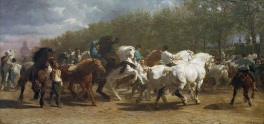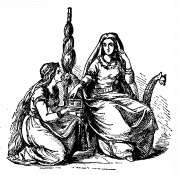|
As we turn the calendrical corner and begin to emerge from Winter, we dwellers in the Northern Hemisphere will see our days lengthen and nights shorten. Here’s a simple working to waken us Whether through shamanic journeying, pulling some tarot cards, taking a meditative walk outside, or any other means you have of visiting your “inner council” place of deep knowledge, a useful question for this time is: “Show me how to best use the energies of the coming year…” If you like, add a defining phrase, such as “…for the healing my heart needs” or “…to assist those around me” or “…to support hands-on positive change for Mother Earth” or… Whatever we think we “ought to” ask about, shape this to what calls you… And, as a potent follow-up question, ask And, whether you’re asking this of a power animal, or your cards, or a cloud or flame with which you’re scrying, may you hear the answer in your heart Because wounds healed in spirit
|
shamanism
Shamanic Journeying with Tarot
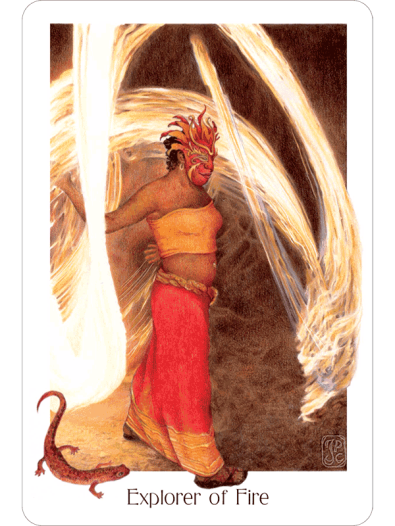
Gaian Tarot © Joanna Powell Colbert (text & illustrations), 2011
In addition to teaching formal classes in both shamanism and Tarot, I’ve been facilitating a journey drumming circle for years. Attendees range from those who have just learned the basics of shamanic journeying through to some very experienced folks, so I’m always open to new ways to let us work together without turning that group into a class. This Tarot-based journeying started a few years ago in a smaller, more experienced group, when I asked my guides to show me a way to bridge the practices of shamanism and Tarot. I’ve been using this basic version in the large, open-attendence circle for about two years now.
How-to:
I spread out both the Gaian and Wildwood Tarot decks, face down.
1. Everyone privately frames a personal question, then draws a card. Basic instruction: “If you do know Tarot meanings, just put them aside for a while.”

Wildwood Tarot © Will Worthington (illustrations), Mark Ryan & John Matthews (text), 2011
We’ve been using these journeys every couple months in the drum circle, and people are reporting wonderful, significant results. The relevance of the information gleaned is validating for all, the newer journeyers especially, and even more so in the partner-journeys. And it allows even the newest, less experienced journeyers to work on behalf of another person in a way that doesn’t feel risky.
This month we added an additional twist: With a new partner (and again working blind), journey to be shown a simple ritual your partner can do right away to help them follow through with what they’ve learned. Lots of crazy and meaningful results, and lots of laughter. I think our power animals love assigning rituals, especially irreverent ones!
If this sounds fun, please try it – I’d love to hear your results and innovations 🙂
Choosing Tarot decks for this: As mentioned, I use the Gaian and Wildwood decks. These both show characters who seem outside of time, with minimal verbiage. In the Wildwood Tarot, all of the Court Cards are animals. [You can use Google images to see more examples from each deck, and both are available as apps from The Fool’s Dog, a great way to see all the details.]
For me, this isn’t the time for the vampire decks, all-cats decks, plain-pip decks, or decks with heaps of glyphs, key words, and other writing. Other good decks might be the World Spirit Tarot or the Tarot de St. Croix – among other strengths, both have vivid art and are multicultural – but there are dozens of other great Tarot decks – Explore!
Bright blessings to all,
Renna Shesso
Mabon – biting the ripe apple
She is well-pleased with the sound of rattles and of timbrels,
with the voice of flutes and the outcry of wolves and bright-eyed lions.
—“Homeric Hymn to the Mother of the Gods,” translation by Hugh G. Evelyn-White
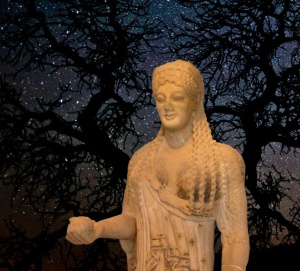 Is there any aroma so evocative as that of a fall morning? As a child, I associated autumn with the scent of burning leaves. Now, as that practice is relegated to the past, I realize the season has a scent of its own, independent of smoking leaf-piles along the curbs. The first hints of chill & damp are in the air, the remnants of gardens are past their peak, some late blooming flowers persist as the weather changes — all lend poignant fragrance to the crisp air.
Is there any aroma so evocative as that of a fall morning? As a child, I associated autumn with the scent of burning leaves. Now, as that practice is relegated to the past, I realize the season has a scent of its own, independent of smoking leaf-piles along the curbs. The first hints of chill & damp are in the air, the remnants of gardens are past their peak, some late blooming flowers persist as the weather changes — all lend poignant fragrance to the crisp air.
As the sun continues to journey southward, our days shift and shorten. And their style of beauty is transformed. Rich autumn colors — gilded with orange and red, often dramatically contrasted by grayer skies — rival the lush beauties of spring with a bittersweet twist: we know these transitional hues will fade rather than spread. Our Mabon holiday marks the Autumnal Equinox, midpoint between Sol’s far north point at Litha and Her distant southerly position at Yule. Check your trusty Farmer’s Almanac. Generally the Equinox falls within a day either way of September 21, based on the Sun’s declination (crossing from north of the equator to south), though the actual days and nights of equal length come a few days later.1
As the final harvest festival, Mabon is often called the Witches’ Thanksgiving. The association of the name “Mabon” with this holiday seems to be of recent and rather loose origin.2 Mabon (“Mab” = son; “on” = deity) was the son of Modron (“Modr” = Mother; “on” = deity). Stolen from His mother and long-imprisoned, finally set free through the help of the animal kingdom, Mabon’s tale makes up a portion of the great Welsh epic, the Mabinogion.3 None of this seems clearly connected with this equinox, until we note that some sources parallel Modron with Demeter, whose Eleusinian Mysteries were celebrated in late September.4,5 Though the details of those rites remain tantalizingly elusive, we know they were closely connected with the Demeter-Kore myth. When Her maiden-daughter Kore is in the Lower World, grieving Mother Demeter withholds Earth’s fertility until Kore returns to visit the Earth’s surface for a portion of each year. The annual Eleusinian rites celebrated Demeter’s fruitful bounties, but their deeper impact concerned the Afterlife we would all eventually face. These ancient rites served to “make happier the hopes of those that participate therein concerning both the end of life and their whole existence.”6
The weeks from this holiday through to the winter solstice tend to be an introspective time for many people, as we pull in our energies and pull out the afghans. Are we mirroring Kore’s sojourn into the Lower World? This can be a time to meet and come to grips with one’s own inner darknesses. Isn’t this what Kore does in agreeing to spend time in the Lower World? The Maiden-daughter transforms: Through Her pilgrimage into the dark (which, in the Homeric Hymn to Demeter, began when she coveted a “phallic” narcissus) Kore Herself becomes Mother.7 The seed of Kore’s mating with Hades gestates in this darkness.
In addition to fall-bright leaves and golden grasses as altar decorations, pomegranates and apples make symbolic and tasty appearances. An apple cut vertically through the center reveals a vaginal-looking view of the core; a horizontal cut through a second apple reveals a pentagram of seeds, an echo of the apple’s five-petalled blossom, flower turned to fruit, Maiden-Kore evolving into Mother-Demeter, holding the promise of new birth. Red apples hold the symbolic hues of the Triple Goddess: a sweet interior of white for the Maiden, a protective skin of red for the Mother, and those Crone-black seeds which will themselves transform to Maiden. From Scandinavia to Avalon, apples symbolized the Afterlife & rebirth.8
According to some versions of this story, it was Kore’s consumption of pomegranate seeds in the Lower World that obliged her to return to that realm annually. In the Bible’s Song of Songs, so rife with symbols, the Bride and Bridegroom come together in a garden of pomegranates. Rock lyrics of the 1950s and ‘60s notwithstanding, the point isn’t that a Maiden-girl-child is transformed into a Mother-woman through the magical wave of a male wand as his sexual love “makes a woman of her.” The point is that the union of female-male energies — physical, spiritual, psychological, emotional, the apparently contradictory elements within ourselves — is transformative. Pomegranate seeds eaten in circle make a wonderful symbolic step onto trance work: As we eat these seeds and accept our darknesses, what do we seek on our journey through the winter? What can our own dark currents teach us? What seeds of change are we harboring within ourselves?
Whether through husbandry or hunting, this is also the season when both domestic and wild animals were traditionally asked to give-away their lives for our larders. The farm animals that had consumed food since spring became food for the winter; wild animals that raised their young and grew plump through the summer were hunted most avidly in the autumn, before they migrated out of range or became scrawny from poor forage once the snows began.
Today we live in an age of year-round factory-farming and “manufactured” meat.9 Many people choose a vegetarian path for various reasons. However, this ancient animal theme is significant and well worth honoring, even if you prefer to carve a slab of tofu rather than turkey. Just as we’ve felt a heightened connection with Mother Earth while consuming the lush summer produce, Mabon can be a time to explore a stronger sense of our symbiotic connection with the animals of our planet. In many cultures, hunted creatures are thanked for giving themselves as food to the people; they’re honored with dances and prayers to help maintain good relationship so the animals will continue to make themselves available to the tribe in the future. Animals, in the flesh and in spirit, dance through so much of our mythology. Animal-helpers — ousel, stag, owl, eagle, salmon — are crucial in the tale of Mabon’s rescue.10 This is a fine time to acknowledge and honor our symbiotic connection with Earth’s other creatures.
RITUAL IDEAS & QUESTIONS
- How are we connecting now with Earth’s animal inhabitants?
- Are we in contact with our power animals?
- How do we honor and respect the animal-based foods we consume?
- As the nights lengthen, how do we perceive and use this darkness?
- Do you have a “dark side”? How do you view, work with and honor it?
- What are we gathering now to carry with us into the winter months?
______________________
“Homeric Hymn to the Mother of the Gods,” translation by Hugh G. Evelyn-White, quoted in The Great Mother, Erich Neumann, (Princeton: Bollingen Series, 1974), p. 271.
1. All celestial data from The Old Farmer’s Almanac
2. I base this on a very brief conversation with Celtic scholar Michael Ranauro at Dragonfest 1996. The linguistic info that immediately follows on the names “Modron” and “Mabon” also came from him.
3. Caitlin and John Matthews, Encyclopædia of Celtic Wisdom, (Elements: Rockport, MA, 1994), pp. 89-91.
4. Janet and Stewart Farrar, The Witches’ God, (Phoenix: Custer WA, 1989), pg. 199.
5. John and Caitlin Matthews, The Aquarian Guide to British & Irish Mythology, (Aquarian Press: Wellingborough, England, 1988), pp. 111, 112-3, 118-9. If we accept Modron/Demeter & Mabon/Kore parallels, have we uncovered evidence of a Celtic/Eleusinian Mystery Rite? Not quite, I think – more like common and persistent themes.
6. The quote is from Isocrates, in Barbara G. Walker, The Women’s Encyclopedia of Myths and Secrets, (Harper & Row: New York, 1983), pp. 218-220.
7. Neumann, ibid., pp. 305-325, on the Eleusinian mysteries.
8. Walker, ibid, pp. 48-50.
9. Jeremy Rifkin, The End of Work (G. P. Putnam’s Sons: New York, 1995), Chapter 8: “No More Farmers,” pp. 109-127, and John Robbins, Diet for a New America, (Stillpoint: Walpole NH, 1987).
10. Matthews, Encyclopædia of Celtic Wisdom, pp. 89-91.
Art: Kore figure, c. 530-520 BC, found on the Acropolis
Predators. Liars. Same thing.
When a counselor (or therapist, healer, teacher, reader, clergy person of any kind – shamanic, pagan, Wiccan, Christian, Buddhist, whatever) tells you that entering a sexual relationship with them will
validate your divine womanhood,
or heal your wounded inner child
(or whatever the f*#% but it sounds great),
and especially if this relationship will be a secret known only between you two…
You are not being validated or healed.
You are being used.
Someone in a position of trust is taking advantage of your vulnerability.
* They are a predator. *
And you probably aren’t the first person to be entrapped, because they know all the key words
to make you feel wonderful and special and compliant.
This isn’t special. It’s predatory, and it’s also oath-breaking conduct that goes against every professional and ethical standard.
And P.S. This is NOT standard or acceptable behavior within the pagan community.
And when you break it off, or when they’re done using you, if they tell you that no one will believe you, that it’s just your word against theirs, they’re lying about that, too, and trying to keep you powerless. How healing is that?
Speaking to trusted friends and Elders helps reclaim your power. Break the isolation and find someone who can hear your truth.
Speaking up makes it harder for this predator to continue stalking your sisters in the community.
And the opposite: Our silence enables them, and helps them keep on using, abusing, preying on the vulnerable. It means we’re keeping the predator’s dirty secret.
Be a good ally to yourself and your sisters. Speak up.
* This note is written from my personal perspective, speaking to what I’ve seen, but this topic does not apply only to women: All variety of people are preyed upon sexually, energetically, psychologically, et. al. Rather than presuming that my voice can adequately to speak to your experience, I encourage you to speak your own truth.
Illustration: “The Fable of the Wolf in Sheep’s Clothing” by Gustave Doré (1832-1883).
Called by Spirit?
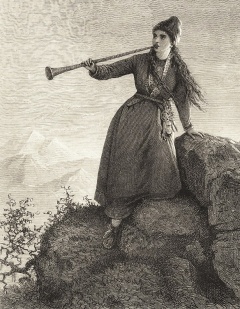 Q: I’ve been told [by a psychic, a shaman, a Tarot reader, a healer I’ve worked with, etc.] that I’m meant to be a shaman and a healer. I’m not even sure what that means! Where do I start?
Q: I’ve been told [by a psychic, a shaman, a Tarot reader, a healer I’ve worked with, etc.] that I’m meant to be a shaman and a healer. I’m not even sure what that means! Where do I start?
A: On questions of prophetic information, my first question is usually “How do you feel about what the person told you? Does that information ring true for you?” Especially when we’re going through confusing times, it’s natural to seek clear direction. But check in with your own inner barometer:
- Does this feel true, right, cosmically familiar, appropriate, appealing?
- Or does it feel – at least for now, at this point in your life – baffling, unappealing, maybe weird or even scary?
We are never obliged to rearrange our lives based on the information delivered by psychics, readers or shamans – really! This is true no matter how much you paid for the reading/session. If what you were told doesn’t ring true or feel right for you, put it aside. This doesn’t mean going to other readers, telling them what you were told and asking for verification – it just means:
Put it aside. If this path is really yours, it will reappear.
If such a message does feel right, a good starting point is a basic workshop in shamanic practices and journeying. Once you’re journeying regularly and developing a strong alliance with a Power Animal or some other Spirit-Plane Guide, that being will let you know if yours is the path of the healer. Since you’ll do any healing work together, building that alliance of mutual trust is the beginning. Without that strong alliance with your Spirit Guides, a shamanic healer’s path isn’t even possible.
If you’re meant to follow a healer’s path, get to know your own Guides: They’ll will make sure you know about it, even rather insistently or over your own objections.
Really, they’ll make sure you know.
This comes from the Frequently Asked Questions page on my website. I teach beginning and advanced shamanic workshops, as do plenty of other experienced and reputable people. You can find many of them here.
Spinning the world into creation
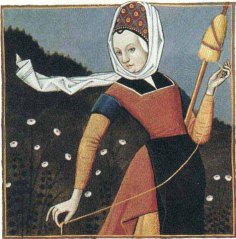
New Years 2014:
I stepped out at midnight to look south and up, to Orion and his belt, always prominently placed in the Solstice-New Years season’s midnight sky. Orion’s three-star belt is easy to find, and usually the “sword stars” below it are clear, too.
But in other lore, the sword stars and the belt above them represent Freyja‘s distaff, the spinning tool that holds the not-yet-spun flax: Here the sword-stars are the shaft and the belt-stars are the fiber-holding prongs. The distaff was the feminine version of a staff of office, especially in the hands of a völva, the shaman-seeress. For her, it was a seidhstafr and represented her spiritual office, and her ability to access the realm of spirit. Rather than fibers, for the seeress the seidhstafr-distaff held potential. As the spinning can direct concentration, the distaff directed the will.
The goddess Frigg was a domestic spinner. Frejya is a the spinner of magic.
____________________________
The image – a woman spinning off a distaff – is French, 15th century.
Breaking a lengthy silence…
…that didn’t involve being silent anywhere but here in the strange terrain of Blogville.
I’ve had a few months of emotional processing that wasn’t the stuff of public posting – the health, hospice and healing and long-term care… or demise – of other people.
And yesterday, I was one of the officiants in a memorial service that felt like it both gave me closure and opened the way, simultaneously. The memorial was for a not-close friend and former student. Over her months in hospice, I gradually became aware of her long-time activity in a variety of wide-ranging areas in her own life – in Wicca, in incest/abuse-recovery, in her lesbian-gay-bisexual-transgendered community, in her vocational circle, in her Daughters of the American Revolution circle. Like me, many of her friends knew her only through one of these avenues. At her memorial, her very Wiccan memorial, people were cross-pollinating between groups and meeting each other for the first time.
And given the nature of the woman we were remembering, those who appeared for her memorial were open, and curious, and willing to share of themselves in sharing their stories about her. There were tears, but some were tears of laughter. People knew her vividly, because that was how she’d lived.
When we imagine a vivid character, there’s a tendency to conjure up the Auntie Mame archetype: an extravagant, wealthy eccentric, someone “living large.” None of that here, since money – or its absence – was often an issue. But character isn’t dependent on cash. Mentions of this woman’s sense of humor wove a quirky strand through so many remembered episodes, humor that was irreverent in laughing at life and at circumstances and at herself, a sense of the absurd. And one person after another spoke of some remembered comment she had made to them, thoughtful words, kindly spoken, freely given at a time and in a way that had deep and lasting significance to that person.
After sharing and laughing and crying, we all shaped ourselves into the rough form of a boat and rowed her spirit into the West and waved farewell. It wasn’t quite what she’d requested: She originally wanted us to build a physical boat.
Sometimes in my shamanic journeying, I used to ask about compassion, to better understand compassion, to know more clearly how to help foster more compassion in myself and in the world.
My power animals and other guides eventually got tired of this. “Quit using these big words. Compassion! Compassion! You and your big words!”
Me: “Well, then, what? Help me understand this better.”
“Forget compassion. Be kind.”
As I absorbed this and let it expand, their short-and-sweet teaching spoke to whether we wanted to perceive ourselves as large-spirited, noble and high-minded beings, or whether we could simply act on the impulse of being kind. The idealized self-perception versus the simple embodied action.
I don’t recall anyone yesterday describing our departed friend as “compassionate.” But they shared story after story that spoke of her kindness.
“Death is that state in which one exists
only in the memory of others,
which is why it is not an end…”
— Tasha Yar, “Star Trek: The Next Generation”
Traditions? Ashes or flames?
Tradition is the handing down of the flame, not the worship of the ashes.”
— Gustav Mahler, Austrian composer and conductor, 1860-1911
I found a version of this quote in Annette Høst’s article “The Legacy of Seidr: History, Experiences and the Path Ahead,” in the latest issue of A Journal of Contemporary Shamanism (Vol. 6, Issue 1, Spring 2013), the membership publication of the Society for Shamanic Practitioners.
This is a spring-cleaning time, whisking out a lot of accumulated excess stuff, especially that stuff that – even if it blazed bright in the past – is now no more energetic than a pile of ash. Physical cleaning is great and cathartic, but the inner cleansing is vital, too, which means out with the beliefs and ideas that no longer serve me. Honoring the past and its lessons doesn’t mean getting stuck there.
So… Bravo for the past service of some items and ideas, but it’s time for dead ashes to be swept away, the better for fresh flames to burn clearly. And Beltane approaches, a good time for inviting fresh fire energy.
__________
Mahler etching by Emil Orlik, c. 1903. This image is in the public domain because its copyright has expired.
The Magical Reappearing Women
Wow, thought young-teenager-me, a woman artist! The only ones I’d ever heard of were Georgia O’Keeffe and Grandma Moses. The name I had found was “Joan Miró.”
Oops. I quickly realized that Joan is a variation on Juan. I felt like crying.
This was during the early 1960s, before the rediscovery of so many female artists during the 1970s, ’80s and ’90s, a resurrection largely driven by the women’s movement. Like an archeological dig into history, there were all these amazing women artists hidden just out of sight, apparently ignored during their own lives and then further forgotten by time. That reclamation is often called herstory.
But guess what? Many of those artists were known, even respected and successful, in their own time. Here’s a tiny list of a few:
- Hildegard of Bingen (1098–1179)
- Artemisia Gentileschi (1593 – c.1656)
- Maria Sibylla Merian (1647 – 1717)
- Rachel Ruysch (1664 – 1750)
- Rosalba Carriera (1675 – 1757)
- Angelika Kauffman (1741 – 1807)
- Mary Moser RA (1744 – 1819)
- Elisabeth Vigee-Le Brun (1755–1842)
- Maria Cosway (1760 – 1838)
- Rosa Bonheur (1822 –1899)
- Elizabeth Thompson, Lady Butler (1846 – 1933)
I’ve seen popular books on art history from the late 1800s that mention many of these artists. Most weren’t been buried very deeply at all until the mid-1900s.
So what the heck happened?
H. W. Janson happened, known to generations of college and university art students as the Janson who wrote History of Art, which first appeared in 1962 and remained the standard art history text for decades.
The number of women artists Janson included? Zero.
This wasn’t an accident. Like Jane Austen’s Mister Darcy describing the rarity of “really accomplished” women, Janson said: “I have not been able to find a woman artist who clearly belongs in a one-volume history of art.” A revised Janson edition in 1986 finally included some women artists: By then, the wealth of research made it impossible to entirely exclude them. (You can find some references listed at the bottom of Wikipedia’s “Women artists” page, and see more images reaching much farther back in time at Suppressed Histories Archives.)
Art, and the absence and eventual re-emergence of women artists, is part of my background and studies, and more viscerally, part of my coming-of-age DNA. I’ve never forgotten this particular gender issue – the lie – but it no longer keeps me awake at night.
Fast forward, from art to shamanism, and Mircea Eliade. He was the author of Shamanism: Archaic Techniques of Ecstasy, (France 1951; in English 1964) an extremely influential popular text on shamanism. Having slogged through Techniques of Ecstasy myself a couple of times, I’d noticed the near-absence of women. I assumed ignorance or worse. It was worse…
Enter Barbara Tedlock’s excellent book, The Shaman in the Woman’s Body. While Tedlock’s focus is on the many powerful women working in shamanism in the world, today and throughout history, she does mention their relative scarcity in recent texts on historical shamanism. In fact, there’s so little mention of women in Eliade and most post-Eliade texts that I’ve had discussions with people – they’ve tended to be male people – who feel they can state for a fact that most shamans are male.
Yet, according to Tedlock, “[Mircea Eliade] never met a living shaman and thus had to depend on published sources.” That’s our expert? Bad enough, but far worse: Contrary to his own source material, Eliade “went out of his way to deny shamanic status to women.” The women that Eliade did mention were generally misidentified as “sorceresses,” or “possessed” or as being engaged in evil or just plain ineffectual practices. 1
And that wasn’t true. From Tedlock again:
One of the authors [Eliade] cited was Jan Jacob Marie de Groot. But de Groot, perhaps the most authoritative source on ancient Chinese religion at the time, had actually noted that women shamans predominated in early Chinese shamanism and that they were considered great healers… [Eliade’s] erasure of women from important religious roles was not even remarked upon for forty years. 2
Sure enough, working off Eliade and subsequent writers who use him as a primary source, many people come away with the erroneous impression that women practitioners are rare in shamanism. And that isn’t true. But Eliade’s prejudices have become a perpetuated lie.
Tedlock’s terrific book – another reclamation – mentions Eliade and “the disappearing act” as just one facet of her rich research. Her focus is on the amazing work that shamanic women have always done and continue to do.
Janson’s and Eliade’s: Have either of these particular old lies impacted your own work? While I love setting my own course, I’ve found that I like knowing that someone has gone before and “broken a trail,” made a path that I can perhaps follow, or at least know that someone else made an attempt. Although art and shamanism both are so inherently idealistic and alive and lit with passion, art can also be isolating, and so can shamanism. Obscuring a trail is a low-minded, sneaky deed. Done like this, it cuts away chances for inspiration and continuity and community.
I’m thinking of all this today because of Pamela Colman Smith, arguably one of the most influential artists in the world. And relatively unknown. She’s the artist behind the 1909 “Rider-Waite” tarot deck. Her work was shown in New York by Alfred Stieglitz at his gallery 291, years before he crossed paths with Georgia O’Keeffe.
Tarot people know Pamela Colman Smith, but she is still nearly unknown outside the realm of tarot. The tarot images she created have inspired dozens – probably hundreds – of other decks, and every day around the world, thousands of people look at her art, or derivations of it, as they have their tarot cards read. Influential and unknown.
For every trail we forge going forward, chances are there are multiple paths tracing back to earlier roots that can help inspire the way.
We’ve got to keep brushing away all the damn dust.
______________
1 Tedlock, Barbara, Ph.D. The Woman in the Shaman’s Body: Reclaiming the Feminine in Religion and Medicine. New York: Bantam Books, 2005, pages 63-64.
2 Tedlock, pg. 64.
North Star, spinning, “baa-ram-ewe…”
I read a post recently from someone looking for “cruelty-free” wool, coming (I guess) from an assumption that all human dealings with domesticated animals are certain to be cruel and exploitive.
Wool isn’t like that. Sheep-shearing doesn’t hurt the sheep any more than a haircut hurts us. It’s done in the spring as the weather warms and the lambs will be arriving. The shearing creates better sanitary conditions for the lambing. And that thick wool “coat” is hot, so the sheep don’t mind having it removed. Another plus: wool is a renewable resource.
Once we just wore animal hides (and perhaps a fig leaf or two). Gradually we clever humanoids figured out how to twist plant fibers together – linen, nettle, the fibrous long-stalked stuff. Eventually a shift from plant fibers to wool changed what we wear. Wool takes dye much better than linen, so our clothing became more colorful, and color-based weaving patterns evolved.
Nowadays, many women are spinning from their own sheep – it’s like the organic gardening of fiber production – and their sheep are treasured and well-treated as the precious resources they are. Wool-production can be a happy symbiotic human-and-critter relationship.
The sheep-raising, shearing, cleaning, combing, spinning are like the farming side of food production (laborious, messy and seasonal/slow), while knitting (and weaving, crochet) are like the delicious and tactile cooking/dining side of it.
Check out Women’s Work: The First 20,000 Years: Women, Cloth, and Society in Early Times by Elizabeth Wayland Barber. It’s a real eye-opener about the role of sheep and wool in human creativity, and about human history in general.
Like many crafts, the fiber arts could also have magical connotations:
“Spinning was associated with woman’s concentration and craft, and with meditation and magic. To spin with intention was a way to magically direct one’s energies… The word seidhr refers to early Norse and Germanic shamanic trance and prophesying, but the word also connotes “string,” “cord,” “snare” and “halter.” In some seidhr-work, the intentions of the völva, the female shaman, are sent forth to seidha til sin, to “attract by seidhr,” as if snaring something and pulling it to you, manipulating from afar. The völva’s staff of office – her seidhstaf – looked like an ornamented distaff…
“The North Star was considered the point of Frigg’s spindle, as if all creation is spinning forth from Her…” – from A Magical Tour of the Night Sky *
This is some of what I think about when I gaze at the North Star. And when I knit.
_________________
* Spinning text © Renna Shesso 2011





